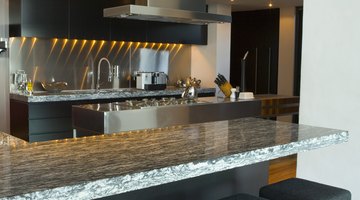What's the Difference Between a Concrete Sealer & Waterproofer?
Concrete sealers and waterproofing compounds perform similar functions in different ways. Sealers primarily form protective layers over concrete surfaces, while waterproofing compounds penetrate into surfaces to fill in gaps. Each type of water repellent or blocking compound has disadvantages and advantages. Choosing which type to apply in your home can be a matter of aesthetic appeal just as much as protective abilities.

Concrete Sealer Types
Concrete sealer is available in four different types: acrylic, polyurethane, epoxy and penetrating. Each type of sealer has a specific use depending on the location of the concrete and which substances you expect the concrete to come into contact with on a regular basis. For example, an acrylic sealer is a breathable substance that repels water while allowing moisture vapor underneath the compound to escape. This is an ideal sealant for concrete that suffers routine exposure to the elements. By contrast, a polyurethane sealer provides thick layers of protection for high-traffic areas of your home but does not allow any trapped moisture to escape.
Concrete Sealer Problems
Some concrete sealers, including polyurethane, have drying periods during which the compounds cannot tolerate exposure to moisture or traffic of any kind. Exposing these sealers to water or other liquids before the layers can sufficiently dry effectively removes any protective layering. According to ConcreteNetwork.com, once the sealers dry, the slippery film these compounds leave may affect your ability to walk across surfaces of your home. Careful and methodical application of sealers is necessary to avoid uneven accumulation, which can throw off the balance of your rooms.
Advantages of Waterproofing
Masonry waterproofing can shore up cracks in a variety of surfaces, including concrete walls, floors and swimming pools. According to the Home Depot's website, masonry waterproofing penetrates into surfaces to bond with the material and close leaks. Waterproofing substances also are more durable than sealants. These compounds stop the flow of water through applied surfaces, block radon gas from leaving the ground and discourage the accumulation of water vapor. Most concrete sealers only repel water from given surfaces, though some sealers do prevent water vapor from forming.
Waterproofing Disadvantages
Repair of concrete with existing cracks or crevices is necessary before applying any waterproofing compound. While a concrete sealer can form a protective layer over the cracks, a waterproofing compound must seep into the concrete. Cracks and crevices hamper the waterproofing compound's ability to halt water damage. According to the Home Depot's website, you can't apply waterproofing to new concrete until the compound has at least 30 days to cure. This means you have to expose your new concrete to the elements for at least a month before you seal it.
References
Writer Bio
Jonathan Lister has been a writer and content marketer since 2003. His latest book publication, "Bullet, a Demos City Novel" is forthcoming from J Taylor Publishing in June 2014. He holds a Bachelor of Arts in English from Shippensburg University and a Master of Fine Arts in writing and poetics from Naropa University.
Photo Credits
- Goodshoot/Goodshoot/Getty Images
- Goodshoot/Goodshoot/Getty Images
More Articles



